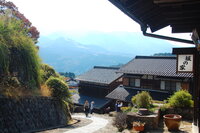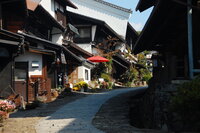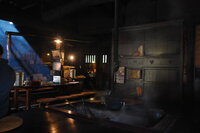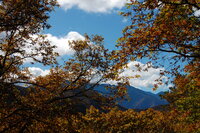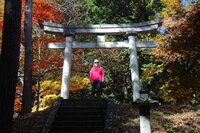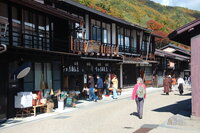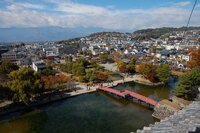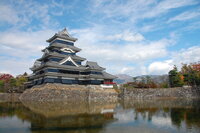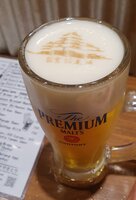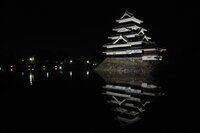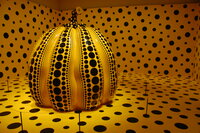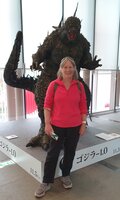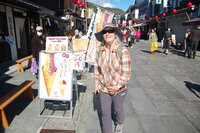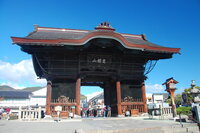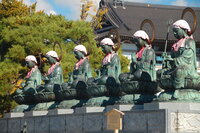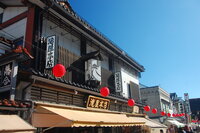We left you in Tokyo, about to brave Shinjuku Station (the world's busiest). As it turns out, the whole adventure was rather straightforward and, with surgical precision (and seat reservations), we caught our onward train. We were heading into the Japanese Alps.
Normally on these blogs, we try and bring you some amusing facts or observations about the places we have visited and the things that we have seen. Indications so far are that this may not be possible this time. Everything seems to work, the people don't seem to do odd things and the language translations (when available) seem to be largely correct. This, in and of itself, is an interesting observation, but it is far from amusing. Time will tell.
The train journey from Tokyo to Matsumoto was rather impressive and reminded us a little of the ride from Ollantaytambo to Aguas Callientes on the way to Machu Picchu. After leaving the flatlands around Tokyo, the Azusa 17 train winds along valleys and through tunnels making its way to the central plain of the Japanese Alps. All whilst being impeccably clean and resolutely punctual. Oh, and the guards bow to you when they enter or leave the carriage - which is nice; and should be encouraged.
The Nakasendō Trail
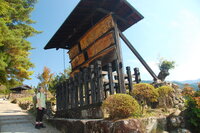
1603 to 1868 was the Edo period in Japan. This was a time of stability and growth under the
strict purview of the shogunate. Amongst the many infrastructure projects executed during this
period was the construction of the Nakasendō trade route between Tokyo and Kyoto. Nakasendō (中山道)
means Central Mountain Route and the entire trail is about 332 miles long. We walked
all of it a small amount of it. Namely, the sections from Magome to Nagiso and from
Yabuhara to Kisohirasawa. Neither of these sections is long (about 7 miles each) and they are pretty
touristy, but this was all we could fit in to our hectic month's schedule.
These sections of the trail pass through some spectacular mountain scenery whilst also clearly having been planned to be as easily navigable as possible for the traders of the day. The staging posts like Magome and Narai are also particularly well planned tourist traps. The walking though, was pretty fun and scenic to boot. It was also not particularly taxing despite what some of the so-called travell bloggers have said. Parts of the trail pass though some dense wooded areas and there is an ever present danger of bear encounters.
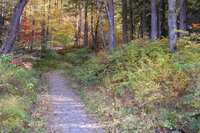
Related to bears, a warning had been issued the day before our first hike stating that bear encounters on the trails had increased by 100% since last year. Helpfully, dotted along the route are bells hanging on posts that are to be rung when passing. Less helpfully, the sign attached to the bell, when translated into English said "Hit against bear!". Now we are not experts in Ursine management, but this feels like epically bad advice and rather provocative. To compound matters, we came across another sign stating "It is very often but, keep in mind that you may encounter bears.". Thankfully, someone had rather optimisitcally inserted a "not". There were a number of people on the trails sporting little bells attached to their rucksacks. Most likely, these were city folk who had read about the practice rather than the hardened back-woodsmen they were trying to look like. Everyone knows the old adage that bears crap in the woods. Not so many know the second stanza which is that their scat is full of bells.
The actual trails meander through forest which, at this time of year, was especially colourful with maples everywhere. Megan claimed she could smell maple syrup! We climbed to 1187m on the Torii Pass which is simultaneously the highest point on the entire Nakasendō trail and also its mid-point. A side-effect of this fact is that the staging post just before the pass (Narai) was particularly prosperous as the travellers partook of some R&R before the climb. Being more worldly than the Edo era Shogun, we did the route in reverse. Like most things touristy, we didn't have to wander far before the crowds disappeared. We wished more of the original cobbles remained even though they were actually rather difficult to walk on. The staging posts have been restored with little of the original architecture remaining (which is unsurprising as it is all constructed from wood). The tourist tat shops were also full of things made of wood.
Matsumoto
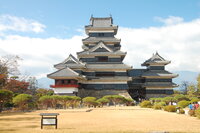
Obviously we spent some time exploring the city of Matsumoto in addition to using it as a base for exploring the Alps. It's a relatively large place for the area and draws in the Japanese tourists as well as the Gaijin (外人, foreigner). This was particularly apparent at the weekend when we had some difficulty finding a place to eat and had to shove in with the crowds (where "shove" means "politely slot in without physical contact").
The main attraction in town is Japan's oldest wooden castle and one of four designated as national treasures. It was completed in 1595 and is largely original, which is not bad for something made from sticks. Of course, for us Brits, making a castle out of anything other than stone seems like madness, but we had better weapons at the time. The castle is also unusual as it was constructed in the valley rather than on a hill. It is nicknamed "Crow Castle" since it is largely black. There are six floors and the stairs connecting them were designed to be particularly difficult to navigate - which they are. We thought we had timed our visit to the castle badly due to our having to queue to see the inside. The queues were caused by the heretofore mentioned difficult stairs. However, we were disabused of this notion upon exit, when we saw what a real queue looked like. In true castle fashion, the construction is surrounded by a moat which, pleasingly, was well stocked with large Japanese fish.
In common with many relics here, we had to remove our shoes to enter. Consider that this castle is entirely made of wood and that thousands of people a day shuffle around in stocking feet and you get an idea of how slippery the floor has become. Also consider that the stairs were designed to resist attackers (61° inclination and 40cm pitch) and you have an idea of how one could break one's neck quite easily in this place. Luckily neither of us did.
We also visited a museum showing some pieces by Yayoi Kusama. Megan claims to have heard of her! It's largely a bunch of dots, but there were also some mirrors that were pretty cool. We were not allowed to take photos inside which is one of the reasons why there is only one shown below.
We spent our off time in Matsumoto, sampling the cafes and restaurants and forming a general opinion of life outside the metropolis that is Tokyo. One thing that is becoming clear (and this will not come as a surprise to some of you) is that the food is not spectacular. Sure, you can pay a large amount of money and have great food as you can in virtually any other location in the world. However, we like to do as normal people do so we try to eat where they do. The results were... not spectacular. Now, we are not scared of unusual foods and have eaten quite a lot of it around the world, but this stuff is just poor. The quality is relatively low and the cooking is not well executed. The principle ingredient in pretty much any dish is salt. Many dishes are deep fried, but with a suspicious rawness to the interior. The ubiquitous grilled meat (Yakitori) is poor quality and again barely cooked. The deep fried octopus balls were... acceptable. We are hoping that this is a feature of rural Matsumoto, but the few dishes we sampled in Tokyo tended to reflect this trend too. We have heard people raving about the food in Japan so our opinion may be misguided. We don't tend to do "fine dining", so this is probably on us.
Nagano
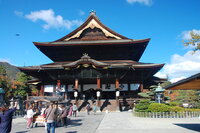
Back on the train again for a day out in Nagano and, unsurprisingly, another Buddhist temple (Zenkō-ji). This one is rather like Sensō-ji in Tokyo but without the crowds. In fact, the entire city appears to be bereft of people in a rather pleasing manner. Sure, there were some tourists, but they all seemed to be locals and school children. We witnessed another fire ceremony like the one in Fukagawa Fudōdō, where small children were immersed in smoke, presumably as some kind of Buddhist blessing. Again, the approach road to the temple was lined with shops. Quite a few of them selling a weird kind of ice cream, that had purple hair on it made out of sweet potato. Let's just file that one under "interesting". Another local food we sampled was Oyaki (おやき) which is like a dumpling stuffed with various items. We tried mushroom, mixed veg, bean paste. Handy they are.
There is a large temple bell hanging outside that we assumed would only be used for important ceremonies, but it turns out that some Buddhist dude comes out on the hour and gives it a good beating, which was nice. The temple has a rather ornate gate that can be climbed (for a small fee). Actually, there's a small fee to do most things at this temple and the canny Buddhists have installed self-serve ticket machines that accept all sorts of payment methods including the Suica pre-pay cards we were using in Tokyo. One special feature is an underground passageway that is completely in the dark. You have to feel your way along completely blind. If you are "lucky enough" to find it,there is a hidden key to your salvation. Oddly, everyone seems to have the same key and we were lucky enough to find our salvation. Good to know!

Tomorrow we leave Matsumoto (or, as the platform announcer pronounces it "Matsumotooooooooooo"). Sad to leave here really. It's a nice place with the ambience of somewhere like Innsbruck, which is probably due to the clear, chilly mountain air and all the people out in the evening and wrapped up and revelling. We've been well looked after here. The hotel have been great and a special mention goes out to housekeeping. Each day, when we returned to the room, it was like one of those puzzles where you have to spot the difference between two pictures. Despite how we left it, our room was returned to an identical state each day - even down to the desk drawer being left open a provocative 2.5" for some reason we never figured out. We began to feel as though we ought be to tidying up in the morning before we went out but really, it's easier to just move on.
Next, we'll be headed north out of the Alps region to the coastal town of Kanazawa. This means we go back up to Nagano and then pick up a train called the "Kagayaki 509"; which sounds like the name of a train that really means business. That's unsurprising as this is a Shinkansen (which is Japanese for "New Main Line"). Of course, we call it the Bullet Train, which is a far cooler name and seems way more appropriate for something called Kagayaki 509. This train will transport us the 141 miles from Nagano to Kanazawa in 1 hour...
...and that includes six stops along the way.
More later.
Some Pictures
